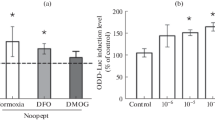Abstract
Nitric oxide (NO) is an important signaling molecule with diverse actions in a wide variety of tissues. NO is a well-known inhibitor of cell growth, DNA replication, and expression of cell-cycle genes. The effect of NO on histone H2B expression was studied in human HEK293 cells. Cell transfection with recombinant plasmids containing the luciferase gene and fragments of the histone H2B promoter region showed that NO attenuated the expression of the reporter gene. The NO-dependent regions responsible for maximal transcriptional suppression of the H2B promoter were localized to the regions of the PPAR-binding site and the minimal promoter (−65/+42 bp from the transcription start). It was assumed that the PRAP-binding site is involved in NO-dependent transcriptional suppression of the histone H2B gene and that this mechanism is associated with NO-dependent modification of low-molecular-weight ligands of PPAR.
Similar content being viewed by others
References
Marzluff W.F., Duronio R.J. 2002. Histone mRNA expression: Multiple levels of cell cycle regulation and important developmental consequences. Curr. Opin. Cell Biol. 14, 692–699.
Heintz N., Sive H.L., Roeder R. 1983. Regulation of human histone gene expression kinetics of accumulation and chandges in the rate of synthesis and in the half-lives of individual histone mRNAs during the HeLa cell cycle. Mol. Cell. Biol. 3, 539–550.
Sive H.A, Heintz N., Roeder R.G. 1986. Multiple sequence elements are required for maximal in vitro transcription of a human histone H2B gene. Mol. Cell. Biol. 6, 3329–3340.
Zhao J., Kennedy B.K., Lawrence B.D., Barbie D.A., Matera A.G., Fletcher J.A., Harlow E. 2000. NPAT links cyclin E-Cdk2 to the regulation of replication-dependent histone gene transcription. Genes Dev. 14, 2283–2297.
Zheng L., Roeder R.G., Luo Y. 2003. S phase activation of the histone H2B promoter by OCA-S, a coactivator complex that contains GAPDH as a key component. Cell. 114, 255–266.
Groves J.T., Wang C.C. 2000. Nitric oxide synthase: Models and mechanisms. Curr. Opin. Chem. Biol. 4, 687–695.
Bogdan C. 2001. Nitric oxide and the regulation of gene expression. Trends Cell. Biol. 11, 66–75.
Kopnin B.P. 2000. Targets for oncogenes and tumor repressors: A key to understanding basic mechanisms of carcinogenesis. Biokhimiya. 65, 5–33.
Timofeev O.V., Pospelova T.V., Pospelov V.A. 2004. Functions of p21Waf1 in norm and in stress. Mol. Biol. 38, 371–385.
Schneiderhan N., Budde A., Zhang Y., Brune B. 2003. Nitric oxide induces phosphorylation of p53 and impairs nuclear export. Oncogene. 22, 2857–2868.
Manuilova E.A., Turpaev K.T., Pankratova E.V. 2007. Role of nitric oxide in regulatig the expression of histone mRNA. Mol. Biol. 41, 571–575.
Fan X., Roy E., Zhu L., Murphy T., Kozlowski M., Nanes M.S., Rubin J. 2003. Nitric Oxide Donors inhibit luciferase expression in a promoter-independent fashion. J. Biol. Chem. 278, 10232–10238.
Neerven S., Mey J. 2007. RAR/RXR and PPAR/RXR signsling in spinal cord injury. PPAP Res. 29275.
Kliewer S.A., Forman B.M., Blumberg B. 1994. Differenyial expression and activation of family of murine peroxisome proliferator-activated receptors. Pros. Natl. Acad. Sci. USA. 91, 7355–7359.
Kota B.P., Huang H.-W., Roufogalis B.D. 2005. An overview on biological mechanisms of PPARs. Pharmacol. Res. 51, 85–94.
Turpaev K.T., Litvinov D.Yu. 2004. Redox-dependent regulation of the expression of nitric oxide-inducible genes. Mol. Biol. 38, 56–68.
Marshall H.E., Merchant K., Stamler J.S. 2000. Nitrosation and oxidation in the regulation of gene expression. FASEB J. 14, 1889–1900.
Wolin M.S. 2000. Interactions of oxidants with vascular signaling systems. Arterioscler. Thromb. Vasc. Biol. 20, 1430–1442.
Sharifpanah F., Wartenberg M., Hanning M., Piper H.M., Sauer H. 2008. Peroxisome proliferator-activated receptor alpha agonists enhance cardiomyogenesis of mouse ES cells by utilization of a reactive oxygen speciesdependent mechanism. Stem Cells. 26, 64–71.
Nagahara T., Okano J., Murawaki J. 2007. Mechanisms of anti-proliferative effect of JTE-522, a selective cyclooxygenase-2 inhibitor, on human liver cancer cells. Oncol. Rep. 18, 1281–1290.
Author information
Authors and Affiliations
Corresponding author
Additional information
Original Russian Text © E.V. Pankratova, E.A. Manuylova, A.G. Stepchenko, 2009, published in Molekulyarnaya Biologiya, 2009, Vol. 43, No. 2, pp. 368–373.
Rights and permissions
About this article
Cite this article
Pankratova, E.V., Manuylova, E.A. & Stepchenko, A.G. Transcription factor-binding sites responsible for NO-dependent repression of the histone H2B promoter. Mol Biol 43, 339–343 (2009). https://doi.org/10.1134/S0026893309020162
Received:
Accepted:
Published:
Issue Date:
DOI: https://doi.org/10.1134/S0026893309020162




